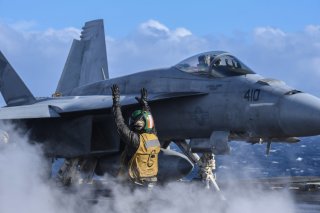Germany's Air Force Is Going All in On the F/A-18 Super Hornet
And more Eurofighters. Here's why.
In a surprise decision with massive implications for both the European and American defense industries, Germany has decided to adopt both the American F/A-18F Super Hornet and additional variants of the Eurofighter Typhoon for their recent program to acquire a strike fighter to replace their fleet of Panavia Tornados. Currently, German plans to procure ninety Eurofighters, and forty-five Super Hornets to replace ninety Tornados.
While Germany’s defense minister, Annegret Kramp-Karrenbauer, fast-tracked the program for the Tornado replacement, saying that she wanted a replacement “as quickly as possible” in September 2019, the quick decision still comes as a surprise given how much is at stake. German unions attempted to dissuade Germany’s defense procurement agency from picking an American jet, warning that a full Super Hornet selection could lead to thousands of lost jobs in the aerospace sector.
The decision to buy both seems to be an effective compromise. Germany is probably banking on the fact that the B61 nuclear bomb can be quickly integrated onto the Super Hornet, both being American-designed weapons. As nuclear delivery was one of the Panavia Tornado’s primary roles (through the NATO Nuclear sharing program), fast replacement of this capability is key to the maintenance of a credible German nuclear deterrent. The Super Hornet also has a dedicated electronic warfare variant, the EA-18 Growler, of which fifteen will be procured as part of the contract. The Growler will act as a direct replacement for the Tornado ECR, the electronic warfare variant of the Tornado which is facing retirement.
While only a partial win, the contract is good news for Boeing, which has struggled to stay afloat following the 737 MAX scandal and reduced orders from an aviation industry shocked by Coronavirus. The win will also make the F/A-18E/F Super Hornet more competitive in Finland’s HX challenge, as one of the Finnish requirements is that the plane’s production lines remain open in the future. While U.S. Navy production is expected to decrease due to their transition to the F-35C and their future carrier-based stealth air superiority fighter, the German win will ensure F/A-18E/F production remains running.
At the same time, the split contract shows how weak of a product the Eurofighter is when competing with other fighter aircraft, due to disparate development and a general lack of funding. While electronic warfare variants of the Eurofighter have been floated as ideas and concepts, none have reached the stage of implementation and testing, which caused its loss to the dedicated electronic warfare variant of the Super Hornet. Eurofighter integration with weapon systems in general has also been notoriously slow, due to almost every country running separate programs to integrate their own weapons onto the fighter. Attempts to remedy this have only succeeded recently, as seen in joint British/German cooperation when it comes to integrating.
However, the surplus Eurofighters in the order indicate that Germany is sticking with the aircraft. Effectively, the ninety Tornados will be replaced by forty-five Eurofighters in the strike role and forty-five Super Hornets in strike, nuclear delivery, and electronic warfare roles. The additional forty-five Eurofighters procured in the order will replace or supplement earlier models of the Eurofighter which are becoming outdated, expanding Germany’s Eurofighter fleet by up to 30 percent assuming no older aircraft are retired. Overall, the 135 plane order represents a significant expansion of capability for the Luftwaffe.
Charlie Gao studied political and computer science at Grinnell College and is a frequent commentator on defense and national-security issues.
Image: Flickr.

